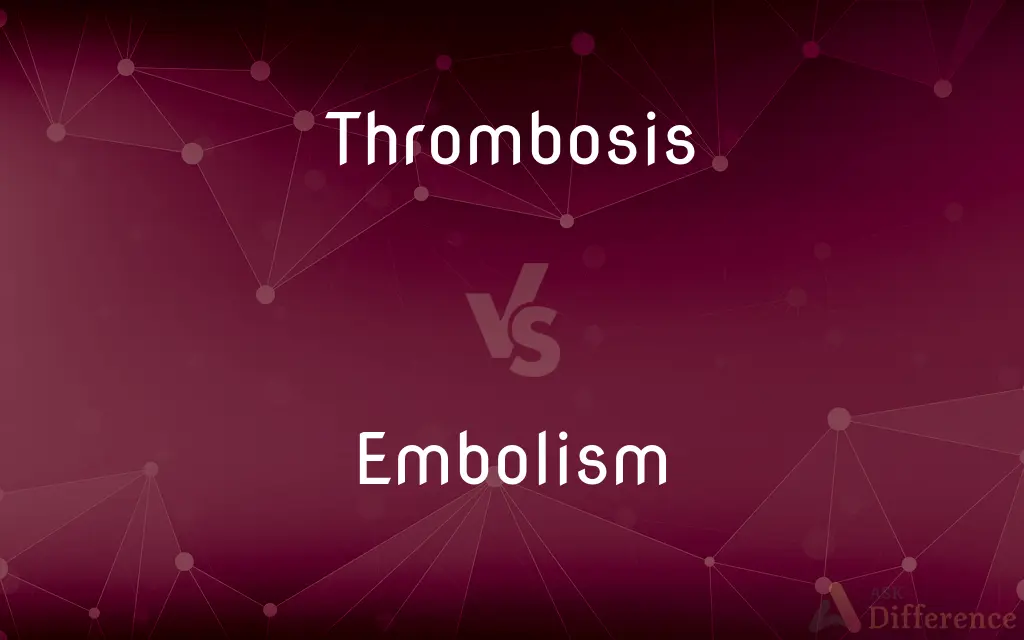Thrombosis vs. Embolism — What's the Difference?
Edited by Tayyaba Rehman — By Fiza Rafique — Updated on March 29, 2024
Thrombosis is the formation of a blood clot within a blood vessel, obstructing blood flow, while an embolism occurs when a clot moves to another part of the body, causing blockage.

Difference Between Thrombosis and Embolism
Table of Contents
ADVERTISEMENT
Key Differences
Thrombosis involves the formation of a blood clot, known as a thrombus, within the vascular system, which can significantly hinder blood flow to vital organs. This condition often arises in veins or arteries and can lead to serious health issues if untreated. On the other hand, an embolism refers to the event where a clot, or part of it, breaks loose and is carried by the bloodstream to another location, where it can block a blood vessel and disrupt the blood supply to organs.
The causes of thrombosis can vary, including factors such as prolonged immobility, certain medical conditions, and surgery. These clots primarily form in the legs, leading to conditions like deep vein thrombosis (DVT). Whereas embolisms often result from clots that travel from their original location, such as parts of a DVT breaking off and traveling to the lungs, causing a pulmonary embolism (PE), which is extremely dangerous.
Symptoms of thrombosis depend on the location of the clot and may include swelling, pain, and redness in the affected area, particularly common in leg DVTs. In contrast, symptoms of an embolism can be sudden and severe, including shortness of breath, chest pain, and in severe cases, collapse, indicating a potentially life-threatening situation like a PE.
Prevention and treatment of thrombosis often involve anticoagulants (blood thinners) to reduce blood clotting, compression stockings to improve blood flow, and lifestyle changes to reduce risk factors. Conversely, treatment for an embolism may require more urgent interventions, such as thrombolytic therapy to dissolve the clot, especially in cases of PE, or surgery in some instances.
Both conditions underscore the importance of early detection and treatment to prevent serious complications. Awareness of risk factors, such as family history, obesity, smoking, and prolonged periods of inactivity, is crucial for both thrombosis and embolism, highlighting the need for preventive measures and prompt medical attention when symptoms arise.
ADVERTISEMENT
Comparison Chart
Definition
Formation of a blood clot within a blood vessel
Movement of a blood clot to another part of the body
Location
Originates and stays at the site of its formation
Travels to different parts of the body
Causes
Immobility, surgery, certain conditions
Clots formed elsewhere, air bubbles, fat droplets
Symptoms
Swelling, pain, redness at the site
Sudden shortness of breath, chest pain, collapse
Treatment
Anticoagulants, compression stockings, lifestyle changes
Thrombolytic therapy, surgery, anticoagulants
Compare with Definitions
Thrombosis
Prevention.
Preventing thrombosis involves regular movement, staying hydrated, and sometimes medication.
Embolism
Pulmonary Embolism.
A common form of embolism is pulmonary embolism, where a clot blocks blood flow to the lungs.
Thrombosis
Blood Clot Formation.
Thrombosis is characterized by the formation of a blood clot inside a blood vessel, impeding blood flow.
Embolism
Urgent Treatment.
Treatment for an embolism often requires urgent medical intervention to restore blood flow.
Thrombosis
Deep Vein Thrombosis.
Deep vein thrombosis is a common type of thrombosis affecting the legs, causing swelling and pain.
Embolism
Varied Sources.
Embolisms can be caused by air, fat, or foreign substances, not just blood clots.
Thrombosis
Risk Factors.
Risk factors for thrombosis include prolonged immobility, obesity, and certain genetic conditions.
Embolism
Symptoms.
Symptoms of an embolism can include sudden breathlessness and chest pain, indicating a serious condition.
Thrombosis
Treatment.
Treatment for thrombosis typically includes anticoagulant medications to prevent clot growth.
Embolism
Clot Migration.
An embolism occurs when a clot or a fragment of it breaks away and obstructs blood flow elsewhere.
Thrombosis
Thrombosis (from Ancient Greek θρόμβωσις thrómbōsis "clotting”) is the formation of a blood clot inside a blood vessel, obstructing the flow of blood through the circulatory system. When a blood vessel (a vein or an artery) is injured, the body uses platelets (thrombocytes) and fibrin to form a blood clot to prevent blood loss.
Embolism
An embolism is the lodging of an embolus, a blockage-causing piece of material, inside a blood vessel. The embolus may be a blood clot (thrombus), a fat globule (fat embolism), a bubble of air or other gas (gas embolism), amniotic fluid (amniotic fluid embolism), or foreign material.
Thrombosis
The formation, presence, or development of a thrombus.
Embolism
Obstruction or occlusion of a blood vessel by an embolus.
Thrombosis
(pathology) The formation of thrombi in the blood vessels of a living organism, causing obstruction of the circulation.
Embolism
An embolus.
Thrombosis
The obstruction of a blood vessel by a clot formed at the site of obstruction; - distinguished from embolism, which is produced by a clot or foreign body brought from a distance.
Embolism
(pathology) An obstruction or occlusion of an artery by an embolus, that is by a blood clot, air bubble or other matter that has been transported by the blood stream.
Thrombosis
The formation or presence of a thrombus (a clot of coagulated blood attached at the site of its formation) in a blood vessel
Embolism
The insertion or intercalation of days into the calendar in order to correct the error arising from the difference between the civil year and the solar year.
Embolism
An intercalated prayer for deliverance from evil coming after the Lord's Prayer.
Embolism
Intercalation; the insertion of days, months, or years, in an account of time, to produce regularity; as, the embolism of a lunar month in the Greek year.
Embolism
Intercalated time.
Embolism
The occlusion of a blood vessel by an embolus. Embolism in the brain often produces sudden unconsciousness and paralysis.
Embolism
An insertion into a calendar
Embolism
Occlusion of a blood vessel by an embolus (a loose clot or air bubble or other particle)
Common Curiosities
Can thrombosis lead to embolism?
Yes, parts of a clot from thrombosis can break off and cause an embolism, such as a pulmonary embolism.
What is the most serious form of embolism?
A pulmonary embolism is considered one of the most serious forms, requiring immediate medical attention.
What might cause an air embolism?
Air embolisms can occur due to medical procedures or diving accidents, introducing air into the bloodstream.
Are thrombosis and embolism treatable?
Both conditions are treatable, often with anticoagulants and, in some cases, surgical intervention.
What are common symptoms of deep vein thrombosis?
Common symptoms include leg pain, swelling, and redness.
How can one prevent thrombosis?
Regular movement, staying hydrated, and avoiding prolonged immobility can help prevent thrombosis.
Can thrombosis occur in arteries as well as veins?
Yes, thrombosis can occur in both arteries and veins, though mechanisms and risks differ.
Is embolism always caused by blood clots?
No, embolisms can also be caused by air, fat, or other substances traveling through the bloodstream.
What is a silent symptom of embolism?
Sometimes embolisms can occur with few or no symptoms, known as "silent" embolisms.
What is the main difference between thrombosis and embolism?
Thrombosis is the formation of a clot within a vessel, while embolism involves a clot traveling and causing a blockage elsewhere.
Who is at risk of developing thrombosis?
People with certain genetic conditions, obesity, smokers, and those with prolonged inactivity are at higher risk.
Can embolism affect the brain?
Yes, an embolism can affect the brain, leading to a stroke, which is a medical emergency.
How are thrombosis and embolism diagnosed?
They are diagnosed through imaging tests like ultrasound for thrombosis and CT scans for embolism.
Can lifestyle changes reduce the risk of these conditions?
Yes, a healthy lifestyle including regular exercise and a balanced diet can reduce the risk.
Do both conditions require hospitalization?
It depends on the severity, but both can require hospitalization, especially if there's a significant risk to the patient.
Share Your Discovery

Previous Comparison
Demeanour vs. Demeanor
Next Comparison
Merger vs. AcquisitionAuthor Spotlight
Written by
Fiza RafiqueFiza Rafique is a skilled content writer at AskDifference.com, where she meticulously refines and enhances written pieces. Drawing from her vast editorial expertise, Fiza ensures clarity, accuracy, and precision in every article. Passionate about language, she continually seeks to elevate the quality of content for readers worldwide.
Edited by
Tayyaba RehmanTayyaba Rehman is a distinguished writer, currently serving as a primary contributor to askdifference.com. As a researcher in semantics and etymology, Tayyaba's passion for the complexity of languages and their distinctions has found a perfect home on the platform. Tayyaba delves into the intricacies of language, distinguishing between commonly confused words and phrases, thereby providing clarity for readers worldwide.













































